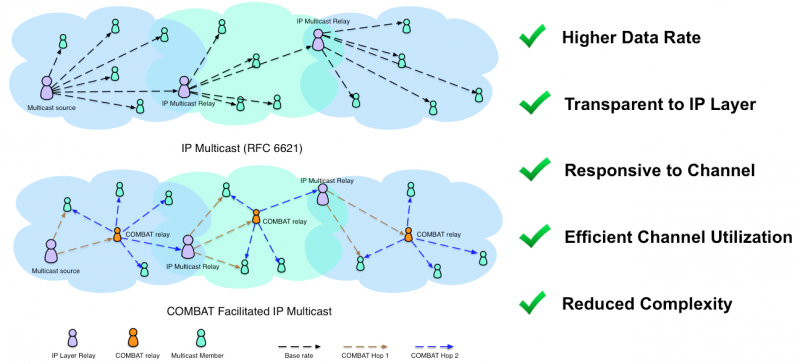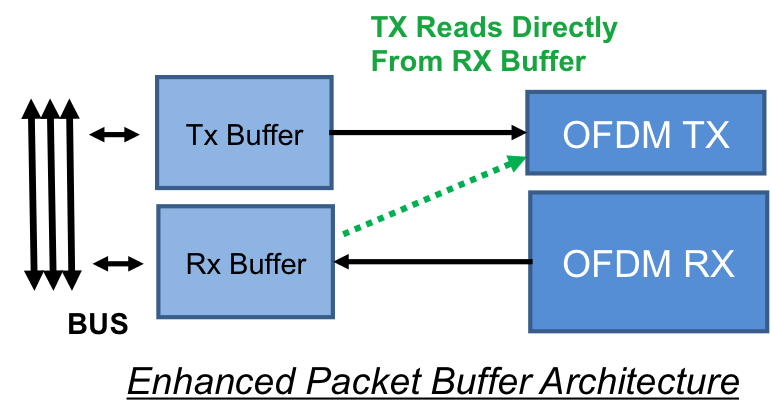COMBAT: Cooperative Multicast and Broadcast at the Tactical Edge
Overview

Wireless multicast is expected to perform a prominent role in tactical communication networks. However, multicast throughput has long been a notorious performance bottleneck in wireless net- works. Due to path losses and shadowing, the link quality at some receivers can be much worse than those at others. This is especially so in contested RF environments. In order to maximize the chance of successfully delivering packets to all receivers, existing wireless systems always employ the most conservative rate (a.k.a. base rate) among all available modulation and coding schemes (MCS) to send packets in the link layer. Using the base rate fundamentally limits the throughput of wireless multicast, which in turn restricts the situational awareness information sharing in tactical edge networks. Besides the problem of low throughput, it is also difficult to implement reliable wireless multicast. Handshaking in reliable transmissions require receiver feedback. For wireless multicast, feedback from multiple receivers for each frame is resource-consuming and hard to co- ordinate. Therefore, multicast packets in IEEE 802.11, for example, are always transmitted at the base rate without acknowledgement.
In short, developing a comprehensive scheme for high throughput and reliable wireless multicast for edge networks is still an unsolved problem that will be addressed with our proposed Cooperative Multicast and Broadcast at Tactical Edge (COMBAT) technology
Research
MAC & PHY ALGORITHMS

COMBAT is a comprehensive scheme for wireless multicast that realizes node cooperation in the link layer instead of the IP and upper layers. Fig. 1 illustrates the key concept behind COM-BAT using the MCS set of IEEE 802.11g. When multicast traffic reaches a distributed network, COMBAT systems opportunistically locate link layer relay nodes. Multicast packets will be sent to the relay node at a high rate; then the relay node sends multicast packets to other multicast sub- scribers, again with high data rates. In existing wireless ad hoc networks, all multicast packets are sent at the base rate. In IEEE 802.11g, the base rate is 6 Mbps. If both the source-relay link and the relay broadcast link achieve the maximum possible rate, i.e., 54 Mbps for IEEE 802.11g, the effective throughput for the multicast traffic is 54/2=27 Mbps, since it takes two hops to finish. The proposed approach achieves a throughput gain of more than 300%. Therefore, the time it takes for the two-hop high data rate transmissions is shorter than a single transmission at a low data rate.
APPROACHES FOR RAPID LOW-LATENCY SDR
Software-Defined Radio platforms often utilize FPGAs to great effect as streaming coprocessors to accelerate the SDR applications. However, FPGA-based SDR environments (such as GNU Radio/RFNOC) do not support feedback loops within the FPGA. This means that all RX-to-TX feedback loops must include host processor. This lengthens these feedback loops significantly and precludes SDR platforms from implementing latency sensitive protocols such a IEEE 802.11. The COMBAT team has successfully modified the E310 SDR board hardware design to support latency-sensitive relay transmissions and is now researching design methods to allow direct feedback loops (within the FPGA) to be designed at a higher abstraction level.

The Figure shows a the modified packet buffer architecture allowing low-latency packet relay. In the Figure, the transmitter can read directly from the RX Packet buffer and avoid data movement from the RX Packet-buffer to the TX packet buffer.
People
ISI Reconfigurable Computing Group
Matthew French, Principal Investigator
Joshua Monson, Computer Scientist
New York University: Polytechnic School of Engineering
Pei Liu, Research Assistant Professor
C-3 Comm Systems, LLC
Zhongren Cao, PhD